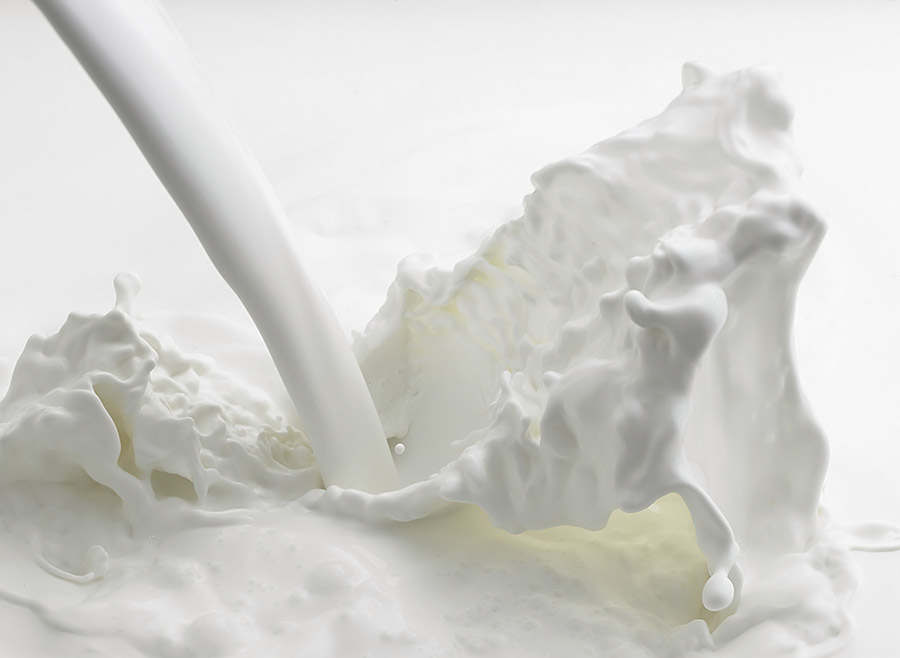milk | butter | kefir | cheese | yogurt | sour cream | buttermilk | sour milk | cottage cheese | curd | pudding
 What Does Milk Contain?
What Does Milk Contain?
Milk is a valuable liquid food product produced by mammary glands containing the macro- and micronutrients necessary for life. Cow’s milk contains about 78% of water. High water content is necessary for dissolving milk components.
The water component of milk is structured, therefore it is suitable for satisfying the primary water need of both newborns and grown-ups, as it is readily absorbed into the bloodstream.
Milk contains over a hundred chemical compounds, most of which have considerable nutritional value. Cow’s milk, the most consumed type of milk in Estonia, contains around 13% of dry matter. It comprises:
- Lipids (mostly fats) 4–5%
- Proteins 2.5–5%
- Carbohydrates (mostly lactose) 4.6–4.8%
- Macro- and microminerals
- Vitamins
- Enzymes
- Hormones
- Pigments
Milk contains lipids mostly in the form of globules. Milk fat is relatively well assimilated due to its low melting temperature, appropriate content of fatty acids, the dispersion of fat globules and how they are absorbed in the gastrointestinal tract.
Milk fat is an important source of energy, especially for a growing and developing organism. Therefore, low-fat milk and milk products shouldn’t be included in the diet of children.
Milk fats have a diverse biochemical composition: they may be saturated, mono-unsaturated and poly-unsaturated. Milk is a very important source of the short- and medium-chain fatty acids that are necessary for the functioning of the myocardium. Several fatty acids in milk have an anti-inflammatory effect, and they also may protect against certain infections.
Milk gets an essential part of its food energy from milk fats. Butter, whipping cream (35%), cheeses with high fat content, ice cream made of cream, glazed cheese curds, curd desserts – all are milk products with higher fat content. If milk is consumed in large quantities, the human body absorbs a considerable amount of milk fat from milk with higher fat content as well.
SMilk contains 0.2–0.3% of sterols, mainly cholesterols. Most of milk cholesterol can be found in the layer covering the fat globules. The lower the fat content of milk the less cholesterol it contains. In case of normal consumption of milk and milk products, this cholesterol content is not dangerous at all.
One glass of full milk with 3.5% fat content contains only 16–28 milligrams of cholesterol, only 8–12 milligrams of which are absorbed in the bloodstream. The human body, however, needs 250–350 milligrams of food cholesterol a day. Moreover, several milk fats have a cholesterol lowering effect in the human body.
Milk proteins contain all the amino acids (including the irreplaceable ones) that the human body needs. Therefore, milk proteins are of extremely high biological value. Casein, the main milk protein, accounts for almost 80% of the milk proteins. Casein is the reserve protein in milk that gives milk its characteristic whitish colour. In addition to amino acids, casein is also a source of phosphorus that is very important for a human body, e.g for the maintenance and development of bones.
Several milk proteins are associated with the symptoms of milk allergy. People allergic to milk proteins should try goat’s milk, as well as fermented (sour) milk products, as fermentation changes the structure of the protein cells, and their allergenicity reduces or disappears altogether. More protein-rich milk products are produced by concentrating the dry matter in milk. These are, for example, cheeses and curd products.
Milk sugar or lactose is an important source of galactose and glycose that have a slightly sweet taste. Lactose fosters the development of an acid environment in the gastrointestinal tract and helps to assimilate calcium.
The gastrointestinal tract of some people cannot assimilate lactose fully or at all. They should prefer products with low milk sugar content, e.g fermented milk products, in their diet. Special lactose-free products are produced for those very few who suffer from lactose intolerance. One has to keep in mind that all the desserts made from milk contain besides milk sugar other sugars, mostly
sucrose.
Milk contains several minerals of course, but first and foremost, milk is an important source of calcium. 100 grams of milk contain on an average 120mg of calcium that can be easily absorbed. In normal conditions, people get about three quarters of the necessary amount of calcium from milk and milk products.
Calcium, potassium, phosphorus and magnesium in milk influence the human body together. They ensure the absorption of micro- and macronutrients and normal bone density, and are responsible for maintaining normal blood pressure. The human body assimilates calcium better from liquid milk products (drinking milk, yogurt, kefir and buttermilk). During the production of solid milk products (cheese, curd) some of the calcium content of raw milk remains in the whey, and does not get into the final products.
A heavy milk drinker also gets zinc, copper, iodine, manganese, iron, cobalt, chromium, molybdenum, fluorine, boron, silicon and selenium from milk. Milk contains almost all water- and fat-soluble vitamins. Of the latter, milk contains plenty of vitamin A and carotenoids, their provitamins, that give milk fat its yellowish colour.
Vitamin D content in milk is not very high, but we receive a considerable amount of its recommended dietary allowance from dairy products. Vitamin D is necessary for calcium absorption and metabolism, and together with calcium, is of vital importance in bone health care. Vitamin E content in milk is about 1mg/l.
Milk contains mostly the following water-soluble vitamins: B₁, B₂, B₃, B₆, B₁₂ and folic acid. Ordinary drinking milk doesn’t represent an important source of Vitamin C. The vitamin content in summer milk and its products is higher than in winter milk and its products.
 What Type of Milk to Choose?
What Type of Milk to Choose?
You may drink raw milk, prefer pasteurized milk with a relatively longer shelf-life, or UHT milk that may be kept for several months. The advantage of raw milk is that its biochemical content (vitamins, enzymes, fat globules, etc) is preserved unchanged after milking. This ensures the high biological value of milk as a food product.
In certain conditions, raw milk may contain pathogens that reproduce if the storage conditions are wrong. In any case, raw milk can be preserved for only a shorter time compared with pasteurized milk. The main aim of pasteurizing milk is to extend its shelf-life and to destroy microbes dangerous to people.
During pasteurization, the natural antibacterial properties of milk are destroyed as most of the milk enzymes become inactive. It also decreases the content of water- and fat-soluble vitamins by one tenth and increases milk acidity to some extent. At the same time, pasteurization partially hinders the degrading of milk fats. Pasteurized milk is not sterile as the bacterial spores retain their viability. After a certain time – depending on the storage conditions – pasteurized milk will spoil microbiologically.
During ultra-heat treatment (UHT) , milk is treated under high pressure at a temperature exceeding 100 °C for a few seconds. In these conditions, both bacteria and their spores are destroyed, thus UHT products can be considered sterile. High temperature also causes certain biochemical alterations in the milk composition (caramelization of milk sugar, structural changes in milk proteins, decrease of vitamin content). The long shelf-life of UHT milk may be considered its primary advantage.
Value Added Products
In addition to traditional lactic acid bacteria, several fermented milk products have special added probiotic lactic acid bacteria. These living bacteria have a positive effect on the microbial habitat of the gastrointestinal tract, and they improve the health of the human organism.
The first Estonian so-called own probiotic bacterium Lactobacillus fermentum ME-3 (LfME-3) was discovered by the scientists of the University of Tartu in 1995. On the basis of thorough research LfME-3 has proven to be a probiotic that has the double package of patented characteristics – antimicrobial and anti-oxidising properties.
Secondly, we should mention probiotic bacteria Lactobacillus plantarum TENSIA™ and Lactobacillus plantarum INDUCIA™ which properties have been studied and described by the Bio-Competence Centre of Healthy Dairy Products in cooperation with the scientists of the University of Tartu.
In addition to its favourable effect on the human intestinal tract Lactobacillus plantarum TENSIA™ decreases systolic and diastolic blood pressure and helps to reduce the risk of cardiovascular diseases. A special property of Lactobacillus plantarum INDUCIA™ is to improve the intestinal mucosal barrier function and to increase the immunological defence system of the human body.
All the aforementioned probiotic bacteria have been isolated from the intestinal tract of Estonian children and their healing effect has been clinically tested and proven.
Only the few probiotic bacterial strains that conform to the stringent requirements are used in commercial production. General requirements for the selection of probiotic bacteria are the following: microflora of human origin, no pathogenetic characteristics, ability to survive the passage through the gastrointestinal tract (especially the stomach), resistance to the effect of bile acids, adhesion to the human intestinal cells, survival and reproduction in the gastrointestinal tract, and positive effect on the human health. The latter may be manifested on several levels.
Long-term research has proven that probiotic bacteria:
- restore the normal microbial habitat in the gastrointestinal tract after treatment with antibiotics,
- improve the cleavage and thus assimilation of milk sugar,,
- change the length of the fatty acid chains enzymatically,
- increase the absorption of B-group vitamins in the intestinal tract,
- improve the assimilation of calcium, iron and phosphorus in the intestinal tract,
- lower the risk of diarrhoea and reduce its duration and effect,
- improve the digestion of elderly people,
- strengthen the immune system,
- prevent the growth of pathogenic bacteria indirectly (by occupying their habitation in the intestines) and directly (by secreting compounds that destroy bacteria),,
- accelerate recovery from intestinal infectious diseases,
- reduce the allergenicity of the milk protein casein,
- reduce the life of dangerous compounds in the gastrointestinal tract and weaken the preconditions for the development of intestinal tumours,
- certain probiotic bacteria improve the regulation of systolic and diastolic blood pressure and help to reduce the risk of cardiovascular diseases. Products containing probiotic bacteria must comply with several requirements, the most important of which is that the bacteria should maintain their viability in the dairy product in correct storage conditions without any major changes until the end of its shelf-life.
Milk is the Source of Vitality
Scientists have discovered over a hundred compounds in cow’s milk that can ensure the normal growth, development and good health of the human organism throughout life.
- Well-assimilated high calcium content ensures strong bones and teeth for a heavy milk drinker.
- Efficient absorption of calcium with magnesium, potassium and phosphorus compounds in milk fosters assimilation of all nutrients and helps to maintain blood pressure within the proper limits.
- Absorption of vital fat-soluble vitamins (vitamin A, its provitamins, vitamins E and D) due to the special structure of milk fats is very efficient.
- Water-soluble vitamins, mostly representatives of the B-group vitamins are in a well-assimilated state as well.
- Many latest clinical studies have proven that regular milk consumption decreases the risk of osteoporosis, the risk of colorectal tumour, and it may lower blood pressure if milk is consumed together with fruits and vegetables.
- Milk products increase saliva secretion, reducing dental plaque and the risk of dental caries. Cheese at the end of a meal reduces acidity in the oral cavity and so is good for tooth enamel.
Share ►


